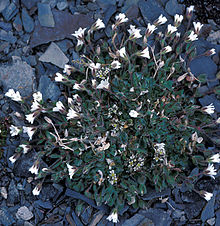| This article needs additional citations for verification. Please help improve this article by adding citations to reliable sources. Unsourced material may be challenged and removed. Find sources: "Cerastium arcticum" – news · newspapers · books · scholar · JSTOR (December 2009) (Learn how and when to remove this message) |
| Cerastium arcticum | |
|---|---|

| |
| Scientific classification | |
| Kingdom: | Plantae |
| Clade: | Tracheophytes |
| Clade: | Angiosperms |
| Clade: | Eudicots |
| Order: | Caryophyllales |
| Family: | Caryophyllaceae |
| Genus: | Cerastium |
| Species: | C. arcticum |
| Binomial name | |
| Cerastium arcticum Lange | |
Cerastium arcticum, the Arctic mouse-ear chickweed or Arctic mouse-ear, is a flower distributed at parts of western and southern Greenland, Baffin Island, Labrador, Iceland, Faroe Islands, Scotland, Norway and Svalbard.
It is a perennial herb that grows in tufts, sometimes loosely, generally in damp places and on open gravel. Most of the plant is pubescent, the hairs appearing stiff. Leaves are elliptical. The flowers are white, rather large, beautiful when fully expanded, single or two together. Petals are deeply notched and considerably longer than sepals.
See also
References
- Aiken, S.G.; et al. "Flora of the Canadian Arctic Archipelago". National Research Council of Canada, Ottawa. Retrieved 17 December 2017.
- "Svalbardflora.no". Svalbardflora.no. Archived from the original on March 18, 2017. Retrieved 17 December 2017.
- "Lady Bird Johnson Wildflower Center - The University of Texas at Austin". www.wildflower.org. Retrieved 2021-12-18.
| Taxon identifiers | |
|---|---|
| Cerastium arcticum |
|
This Caryophyllaceae article is a stub. You can help Misplaced Pages by expanding it. |

